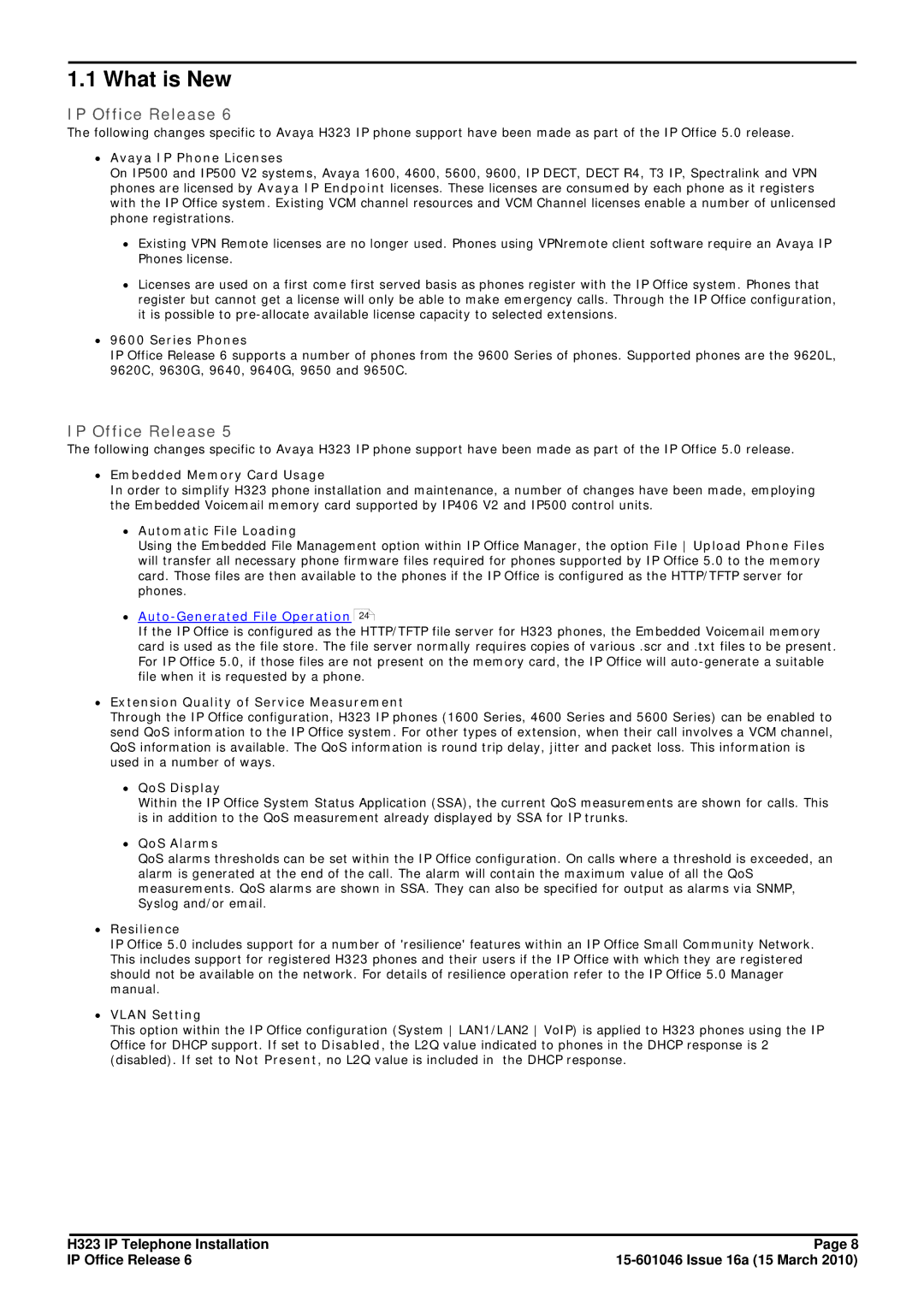
1.1 What is New
IP Office Release 6
The following changes specific to Avaya H323 IP phone support have been made as part of the IP Office 5.0 release.
∙Avaya IP Phone Licenses
On IP500 and IP500 V2 systems, Avaya 1600, 4600, 5600, 9600, IP DECT, DECT R4, T3 IP, Spectralink and VPN phones are licensed by Avaya IP Endpoint licenses. These licenses are consumed by each phone as it registers with the IP Office system. Existing VCM channel resources and VCM Channel licenses enable a number of unlicensed phone registrations.
∙Existing VPN Remote licenses are no longer used. Phones using VPNremote client software require an Avaya IP Phones license.
∙Licenses are used on a first come first served basis as phones register with the IP Office system. Phones that register but cannot get a license will only be able to make emergency calls. Through the IP Office configuration, it is possible to
∙9600 Series Phones
IP Office Release 6 supports a number of phones from the 9600 Series of phones. Supported phones are the 9620L, 9620C, 9630G, 9640, 9640G, 9650 and 9650C.
IP Office Release 5
The following changes specific to Avaya H323 IP phone support have been made as part of the IP Office 5.0 release.
∙Embedded Memory Card Usage
In order to simplify H323 phone installation and maintenance, a number of changes have been made, employing the Embedded Voicemail memory card supported by IP406 V2 and IP500 control units.
∙Automatic File Loading
Using the Embedded File Management option within IP Office Manager, the option File Upload Phone Files will transfer all necessary phone firmware files required for phones supported by IP Office 5.0 to the memory card. Those files are then available to the phones if the IP Office is configured as the HTTP/TFTP server for phones.
∙
24
If the IP Office is configured as the HTTP/TFTP file server for H323 phones, the Embedded Voicemail memory card is used as the file store. The file server normally requires copies of various .scr and .txt files to be present. For IP Office 5.0, if those files are not present on the memory card, the IP Office will
∙Extension Quality of Service Measurement
Through the IP Office configuration, H323 IP phones (1600 Series, 4600 Series and 5600 Series) can be enabled to send QoS information to the IP Office system. For other types of extension, when their call involves a VCM channel, QoS information is available. The QoS information is round trip delay, jitter and packet loss. This information is used in a number of ways.
∙QoS Display
Within the IP Office System Status Application (SSA), the current QoS measurements are shown for calls. This is in addition to the QoS measurement already displayed by SSA for IP trunks.
∙QoS Alarms
QoS alarms thresholds can be set within the IP Office configuration. On calls where a threshold is exceeded, an alarm is generated at the end of the call. The alarm will contain the maximum value of all the QoS measurements. QoS alarms are shown in SSA. They can also be specified for output as alarms via SNMP, Syslog and/or email.
∙Resilience
IP Office 5.0 includes support for a number of 'resilience' features within an IP Office Small Community Network. This includes support for registered H323 phones and their users if the IP Office with which they are registered should not be available on the network. For details of resilience operation refer to the IP Office 5.0 Manager manual.
∙VLAN Setting
This option within the IP Office configuration (System LAN1/LAN2 VoIP) is applied to H323 phones using the IP Office for DHCP support. If set to Disabled, the L2Q value indicated to phones in the DHCP response is 2 (disabled). If set to Not Present, no L2Q value is included in the DHCP response.
H323 IP Telephone Installation | Page 8 |
IP Office Release 6 |
